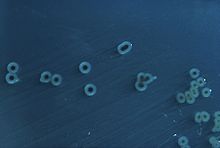Salmonella enteritidis
| Salmonella enterica | |
|---|---|
 |
|
| Salmonella Typhimurium colonies on a Hektoen enteric agar plate | |
| Scientific classification | |
| Kingdom: | Bacteria |
| Phylum: | Proteobacteria |
| Class: | Gammaproteobacteria |
| Order: | Enterobacteriales |
| Family: | Enterobacteriaceae |
| Genus: | Salmonella |
| Species: | S. enterica |
| Subspecies: | S. e. subsp. enterica |
| Trinomial name | |
|
Salmonella enterica subsp. enterica |
|
| Serovar | |
|
|
Salmonella enterica subsp. enterica is a subspecies of Salmonella enterica, the rod-shaped, flagellated, aerobic, Gram-negative bacterium. Many of the pathogenic serovars of the S. enterica species are in this subspecies, including that responsible for typhoid.
S. enterica subsp. enterica contains a large number of serovars which can infect a broad range of vertebrate hosts. The individual members range from being highly host-adapted (only able to infect a narrow range of species) to displaying a broad host range. A number of techniques are currently used to differentiate between serotypes. These include looking for the presence or absence of antigens, phage typing, molecular fingerprinting and biotyping, where serovars are differentiated by which nutrients they are able to ferment. A possible factor in determining the host range of particular serovars is phage-mediated acquisition of a small number of genetic elements that enable infection of a particular host. It is further postulated that serovars which infect a narrow range of species have diverged from ancestors with a broad host range, and have since specialised and lost the ability to infect some hosts.
A selection of serovars, with known hosts listed. Since there are more than 2500 serovars of Salmonella enterica subsp. enterica, this list is incomplete.
A study of data from 37 countries collected between 2001 and 2007 found that the most common serovars of Salmonella isolated from human cases was enteritidis, found in an average of 43.5% of cases, followed by Typhimurium (17.1% of cases), Newport (3.5%), Infantis (1.8%), Virchow (1.5%), Hadar (1.5%), and Agona (0.8%).
One strain of Salmonella that has recently been emerging in the United States is Salmonella javiana. "An outbreak occurred in 2002, there were 141 cases that occurred among the participants of the U.S. Transplant Games. Out of the 141 cases, most of the cases were either transplant recipients (34%) or people receiving immunosuppressive therapy (32%)". There is an increasing number of Salmonella serotypes that are multidrug resistant (MDR), which was identified by the CDC's National Antimicrobial Resistance Monitoring System. "Salmonella javiana causes 4% of nontyphodial Salmonella infections in the United States each year."
...
Wikipedia
